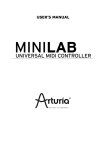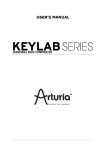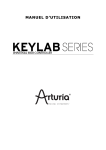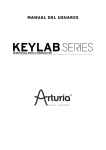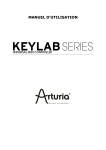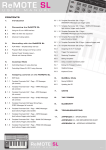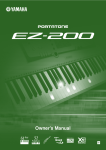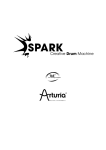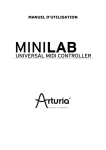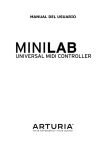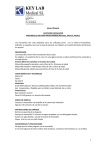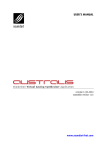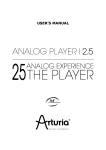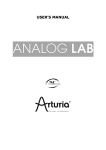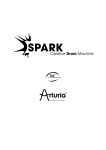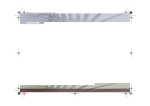Download User Manual EN
Transcript
USER’S MANUAL PROGRAMMING: Robert Bocquier Tyler Pei INDUSTRIALIZATION: Nicolas Dubois MANUAL: Randy Lee Sebastien Rochard Tomoya Fukushi Jerome Parrod DESIGN: Glen Darcey Axel Hartmann Morgan Perrier © ARTURIA SA – 1999-2013 – All rights reserved. 4, Chemin de Malacher 38240 Meylan FRANCE http://www.arturia.com Information contained in this manual is subject to change without notice and does not represent a commitment on the part of Arturia. The software described in this manual is provided under the terms of a license agreement or non-disclosure agreement. The software license agreement specifies the terms and conditions for its lawful use. No part of this manual may be produced or transmitted in any form or by any purpose other than purchaser’s personal use, without the express written permission of ARTURIA S.A. All other products, logos or company names quoted in this manual are trademarks or registered trademarks of their respective owners. April 2013 edition 2 ARTURIA – KeyLab – USER’S MANUAL Tha nk you for purchasing the Arturia Key Lab ! This manual covers the features and operation of the Arturia KeyLab, a full-featured MIDI controller designed to work with any DAW software or plug-in you own. Note: While the KeyLab is part of a package which includes our Analog Lab software, this manual will focus only on the KeyLab controller hardware. Please refer to the Analog Lab user manual in order to learn about the features of the software. In this package you will find: § One KeyLab keyboard controller § One USB cable § The Quick Start Guide for the KeyLab. This document has a sticker on the inside of its front cover providing the serial number and registration code you will need in order to register your KeyLab online and authorize the Analog Lab software. Be sure to store your registration information carefully! It contains the serial number that is required during the online registration process. Registering your KeyLab provides the following benefits: • It enables you to download the Analog Lab software installer and user manual, the KeyLab user manual, and the KeyLab MIDI Control Center software • It provides by e-mail the unlock code you will need to authorize the Analog Lab software on your computer. See Chapter 3 of the Analog Lab user manual for more information about its authorization procedure. ARTURIA – KeyLab – USER’S MANUAL 3 Special Message Section SPECIFICATIONS SUBJECT TO CHANGE: The information contained in this manual is believed to be correct at the time of printing. However, Arturia reserves the right to change or modify any of the specifications without notice or obligation to update the hardware that has been purchased. IMPORTANT: The product and its software, when used in combination with an amplifier, headphones or speakers, may be able to produce sound levels that could cause permanent hearing loss. DO NOT operate for long periods of time at a high level or at a level that is uncomfortable. If you encounter any hearing loss or ringing in the ears, you should consult an audiologist. NOTICE: Service charges incurred due to a lack of knowledge relating to how a function or feature works (when the product is operating as designed) are not covered by the manufacturer’s warranty, and are therefore the owner's responsibility. Please study this manual carefully and consult your dealer before requesting service. PRECAUTIONS INCLUDE, BUT ARE NOT LIMITED TO, THE FOLLOWING: 1. Read and understand all the instructions. 2. Always follow the instructions on the instrument. 3. Before cleaning the instrument, always remove the USB cable. When cleaning, use a soft and dry cloth. Do not use gasoline, alcohol, acetone, turpentine or any other organic solutions; do not use a liquid cleaner, spray or cloth that's too wet. 4. Do not use the instrument near water or moisture, such as a bathtub, sink, swimming pool or similar place. 5. Do not place the instrument in an unstable position where it might accidentally fall over. 6. Do not place heavy objects on the instrument. Do not block openings or vents of the instrument; these locations are used for air circulation to prevent the instrument from overheating. Do not place the instrument near a heat vent or any place of poor air circulation. 7. Do not open and insert anything into the instrument that may cause a fire or electrical shock. 8. Do not spill any kind of liquid onto the instrument. 9. Always take the instrument to a qualified service center. You will invalidate your warranty if you open and remove the cover, and improper assembly may cause electrical shock or other malfunctions. 10. Do not use the instrument with thunder and lightning present; otherwise it may cause long distance electrical shock. 11. Do not expose the instrument to hot sunlight. 12. Do not use the instrument when there is a gas leak nearby. 13. Arturia is not responsible for any damage or data loss caused by improper operation of the instrument. 4 ARTURIA – KeyLab – USER’S MANUAL Table of Contents 1 INTRODUCTION .......................................................................................................................................... 7 2 KEYLAB OVERVIEW.................................................................................................................................. 8 2.1 FIRST STEP: MAKING THE CONNECTIONS ................................................................................................... 8 2.2 FRONT PANEL OVERVIEW ........................................................................................................................... 9 2.2.1 Keyboard .......................................................................................................................................... 11 2.2.2 Pitch and Modulation touch Wheels................................................................................................. 11 2.2.3 Octave buttons .................................................................................................................................. 11 2.2.4 Volume rotary encoder ..................................................................................................................... 12 2.2.5 Sound/Multi/Edit section .................................................................................................................. 12 2.2.5.1 2.2.5.2 2.2.5.3 2.2.5.4 Sound/Multi buttons ..................................................................................................................................... 12 Edit button .................................................................................................................................................... 12 Category/Param encoder .............................................................................................................................. 12 Preset/Value encoder .................................................................................................................................... 13 2.2.8.1 2.2.8.2 2.2.8.3 2.2.8.4 2.2.8.5 Filter ............................................................................................................................................................. 16 LFO .............................................................................................................................................................. 16 FX mix ......................................................................................................................................................... 16 Key parameters ............................................................................................................................................. 16 Envelopes ..................................................................................................................................................... 17 2.2.6 Snapshots buttons ............................................................................................................................. 13 2.2.7 Transport Controls ........................................................................................................................... 15 2.2.8 Synthesis section ............................................................................................................................... 16 2.2.9 Pads (KeyLab 49 and Keylab 61 only) ............................................................................................. 17 2.3 REAR PANEL OVERVIEW ........................................................................................................................... 18 2.3.1 MIDI connections ............................................................................................................................. 18 2.3.2 Power supply .................................................................................................................................... 18 2.4 BASIC MIDI CONTROL ............................................................................................................................. 18 3 USING KEYLAB WITH ANALOG LAB ................................................................................................. 19 3.1 AUDIO & MIDI SETUP ............................................................................................................................. 19 3.1.1 Audio setup ....................................................................................................................................... 19 3.1.2 MIDI setup ........................................................................................................................................ 20 3.2 SELECTING PRESETS ................................................................................................................................. 20 3.2.1 The Analog Lab “Preset” ................................................................................................................. 20 Selecting ................................................................................................................................................... 20 3.2.2 KeyLab Presets 1-11......................................................................................................................... 20 3.3 SETUP ....................................................................................................................................................... 21 3.4 USING THE KNOBS AND SLIDERS.............................................................................................................. 21 3.5 USING THE PADS (KEYLAB 49 AND KEYLAB 61) ..................................................................................... 22 3.6 USING THE SNAPSHOTS ............................................................................................................................ 22 4 MIDI CONTROL CENTER ....................................................................................................................... 23 4.1 SYSTEM REQUIREMENTS: MIDI CONTROL CENTER ................................................................................. 23 4.1.1 REQUIRED MINIMUM CONFIGURATION: ................................................................................. 23 4.1.2 PLATFORM SPECIFICATIONS: .................................................................................................... 23 4.2 INSTALLING THE KEYLAB MIDI CONTROL CENTER SOFTWARE .............................................................. 23 4.3 LAUNCHING THE MIDI CONTROL CENTER .............................................................................................. 24 4.3.1 The virtual keyboard and its controls ............................................................................................... 24 4.3.2 The Global and Selected Control Parameter sections ..................................................................... 24 4.4 CHANGING MIDI SETTINGS ...................................................................................................................... 24 4.4.1 Global parameters ............................................................................................................................ 24 4.4.2 Selected Control parameters ............................................................................................................ 24 4.4.2.1 4.4.2.2 4.4.2.3 4.4.2.4 4.4.2.5 4.4.2.6 Settings for the Encoders.............................................................................................................................. 26 Settings for the sliders .................................................................................................................................. 27 Settings for the Pads (Keylab 49 and Keylab 61) ........................................................................................ 28 Settings for the Buttons ................................................................................................................................ 29 Settings for the Modulation Wheel .............................................................................................................. 30 Settings for the Pedals .................................................................................................................................. 30 4.4.3 Send your settings to the keyboard ................................................................................................... 31 ARTURIA – KeyLab – USER’S MANUAL 5 4.4.4 Restoring the default values ............................................................................................................. 31 4.4.5 Saving settings to the computer ........................................................................................................ 31 4.4.6 Loading settings from the computer ................................................................................................. 32 5 USING KEYLAB WITH OTHER SOFTWARE ...................................................................................... 33 5.1 CREATING MIDI PRESETS WITH THE MIDI CONTROL CENTER................................................................ 33 5.1.1 Overview: What is a KeyLab Preset? ............................................................................................... 33 5.1.2 Assign a Pad to toggle a MIDI CC # between two values................................................................ 33 5.1.3 Assign an Encoder to control a MIDI CC # between two values ..................................................... 34 5.1.4 Save the changes to a Preset ............................................................................................................ 35 5.1.5 Recalling a Preset / Switching between Presets ............................................................................... 35 5.2 CHANGING THE GLOBAL MIDI CHANNEL................................................................................................ 36 6 ARTURIA KEYLAB – LEGAL INFORMATION ................................................................................... 37 6.1 6.2 6.3 6.4 6 SOFTWARE LICENSE AGREEMENT ................................................................................................. 37 FCC INFORMATION (USA) ................................................................................................................. 39 CANADA ................................................................................................................................................ 40 EUROPE.................................................................................................................................................. 40 ARTURIA – KeyLab – USER’S MANUAL 1 INTRODUCTION Keylab is Arturia's newest series of USB MIDI Keyboards. The Keylab 25, Keylab 49 and Keylab 61 all feature a velocity and aftertouch sensitive keyboard. They offer a control surface designed for perfect integration with our software synthesizers. The attention to detail poured into KeyLab also makes it perfect for working with any other software plugin or DAW you have available. Beyond being a great MIDI controller, KeyLab comes with our Analog Lab software that includes an astounding arsenal of classic synth and keyboard sounds. The integration of these two products results in a powerful hybrid synthesizer with excellent functionality and great sound. The 2 clickable encoders, 11 encoders, 9 sliders, 13 switches, 6 transport switches, modulation and pitch bend wheel give you the control you need to exploit the full potential of any USB audio product you encounter. The 49 and 61 versions also offer 16 velocity and pressure sensitive pads that can be assigned as pads, MIDI CC buttons, or program change switches. You will also find MIDI In and Out connectors, Expression, Sustain and Aux pedal inputs as well as a breath controller input. On top of that, the included MIDI Control Center software lets you map parameters to the controllers and pads in a simple and easy way directly from your computer and store them into presets. Those presets are then stored in the KeyLab hardware for instant recall. ARTURIA – KeyLab – USER’S MANUAL 7 2 KEYLAB OVERVIEW 2.1 First step: Making the connections Setting up the KeyLab keyboard for use with Analog Lab is fast and simple: 8 1) First install the Analog Lab program on your computer and be sure to register and authorize it (see Chapters 2 and 3 of the Analog Lab user manual). 2) Connect the KeyLab keyboard to the computer. KeyLab is powered by its USB connection, so all you have to do is connect a USB cable from your computer to the KeyLab keyboard. 3) KeyLab is a class-compliant USB device, so its driver will be automatically installed when you connect KeyLab to your computer. 4) Fire up the Analog Lab software and read on! ARTURIA – KeyLab – USER’S MANUAL 2.2 Front panel overview KeyLab25 front panel KeyLab49 front panel ARTURIA – KeyLab – USER’S MANUAL 9 1: Category/Param and Preset/Value knobs The Category/Param encoder selects a filter option for the preset list. In Edit mode, it selects an item parameter. The Preset/Value encoder selects a preset in the Presets list. In Edit mode, it edits the value of the hereabove item parameter. Both knobs are clickable to enter the values. 2: Snapshots buttons Use with Analog Lab to recall favorite presets (Snapshots). For other software programs use the MIDI Control Center software to alter the buttons’ assignments. 3: Transport buttons These buttons allow controlling hardware or software sequencer. any external Buttons send standard MMC messages: Start, Stop, record, Rewind, Fast Forward and Loop. They can be customized in the MIDI Control Center. 4: LCD screen 32 digit LCD screen. 5: Sound/Multi/Edit buttons The Sound/Multi buttons allow toggling between both modes in Analog Lab. The Edit button can set the KeyLab in edit mode, to provide advanced editing of the controls 6: Volume knob The Volume rotary encoder sets the general volume of Analog Lab. 7: Bank buttons The Bank buttons allow to toggle between two group of controller assignations for both the Encoders and the Faders. 8: Encoders These rotary encoders allow for control of the synthesis parameters of your presets in Analog Lab, or to control any other device. 9: Faders These faders allow for control of the synthesis parameters of your presets in Analog Lab, or to control any other device. 10: Octave up/down buttons Allows for transposition of the keyboard up to three octaves up or down. The blinking state will help you to visually locate the current octave setting. 11: Pitch bend/Mod Wheel These two controllers are used for real time pitch shift and modulation amount settings. 12: Pads (KeyLab 49/61 only) The 16 pads on the top right of the keyboard controller can be used to trigger chords in Analog Lab. They are also generic velocity and pressure sensitive pads that can be configured in the MIDI Control Center. 10 ARTURIA – KeyLab – USER’S MANUAL 2.2.1 Keyboard The KeyLab 25, 49 and 61 have 25, 49 and 61-key velocity and aftertouch-sensitive keyboards with a control surface designed for perfect integration with the Analog Lab software interface. 2.2.2 Pitch and Modulation touch Wheels These two controllers are used for real time pitch shift and modulation amount settings. Moving the Pitch Wheel up or down alters the pitch of the played sound. The octave range of the pitch wheel depends on which preset is selected. Moving the Modulation Wheel up or down alters the modulation amount of the played sound. The level of modulation introduced by moving the modulation wheel depends on which preset is selected. The modulation wheel is not necessarily connected on every preset! It will depend on the preset being used.selected. The modulation Wheel may not be assigned to modulate a parameter in some presets. Pitch and Modulation Wheels 2.2.3 Octave buttons Pushing the Up or Down button will allow you to transpose as much as three octaves up or down . Seven states of leds will help you to visually locate the current octave setting: • Octave -3: led- blinks at speed 3, led+ does not blink • Octave -2: led- blinks at speed 2, led+ does not blink • Octave -1: led- blinks at speed 1, led+ does not blink • Octave 0: led– and led+ do not blink • Octave +1: led+ blinks at speed 1, led- does not blink • Octave +2: led+ blinks at speed 2, led- does not blink • Octave +3: led+ blinks at speed 3, led- does not blink) ARTURIA – KeyLab – USER’S MANUAL 11 Octave buttons 2.2.4 Volume rotary encoder Turning the “Volume” rotary encoder sets the general volume of Analog Lab. In typical Use with other products, you will assign this to MIDI CC #7. Volume knob 2.2.5 Sound/Multi/Edit section Sound/Multi/Edit buttons 2.2.5.1 Sound/Multi buttons The Sound and Multi buttons allow toggling between both modes in Analog Lab. 2.2.5.2 Edit button The Edit button is used to edit the parameters of the current preset. When the button is pushed it will call a secondary function you cannot get in the initial mode. This button lights up when the Edit mode is activated. When the Edit mode is activated, the interface changes as follow: • The Category encoder now selects the item Parameter; • The Preset encoder now sets the item Value: this must be explicitly validated using the “push” action of the encoder. When this mode is entered, the LCD display shows the currently edited name and values. 2.2.5.3 Category/Param encoder The Category/Param encoder allows to select a filter option in the Analog Lab preset list. In Edit mode, this encoder selects an item Parameter. 12 ARTURIA – KeyLab – USER’S MANUAL 2.2.5.4 Preset/Value encoder In Analog Lab, this button allows to select a preset in the Presets Manager. This is a “push” encoder, press it to validate your choice. In Edit mode, it edits the Value of the hereabove item Parameter; push the encoder to validate this value. 2.2.6 Snapshots buttons In Analog Lab, the Snapshots buttons enable you to recall Sounds and Multis. Snapshots are direct links to a selection of 10 favorite programs, allowing quick access to the essential sounds. To save a snapshot program, press and hold on one of the 10 buttons for a time superior for more than 1 second. All editable functions of Analog Lab are saved within the snapshot. To recall a snapshot program, just press one of these buttons. All editable functions of Analog Lab are restored with the snapshot. The snapshots buttons take on alternative functions when the Edit mode is activated. The 10 snapshot buttons now select these categories: Mode Set the controller mode for a specific controller. Available modes are: • Off: the controller is disabled, and no message is sent whatsoever. • Control: the standard (absolute) MIDI control. For knobs, a virtual position is maintained internally. • Relative Control: the knobs send relative increment/decrement values. Relative control modes are supported in some software applications and not in others • RPN/NRPN: these modes transmit (N)RPN messages. The target controller is programmed in Max/MSB and Min/LSB parameters. Chan Set the channel used to transmit data for a specific item: • 1-16: explicit MIDI channel. • Lwr: the current lower channel. • Upr: the current upper channel. • Pnl: either upper or lower channel, according to the state of the “Panel” buttons. Num MIDI number for a specific item: • For a pad or button in note mode, contains the actual note number. • For the transport buttons in MMC mode, contains the MMC command number. • For a knob or fader in NRPN/RPN mode, contains the actual controller number used for data transmission (6 or 38). • For a button in Prog mode, holds the program change number. Min LSB • Various functions depending on the controller: For a knob, pad or fader in Ctrl mode, contains the minimum value sent. ARTURIA – KeyLab – USER’S MANUAL 13 • For a knob or fader in NRPN/RPN mode, contains the NRPN/RPN controller number LSB (Less Significant Byte). • For a button in Ctl mode, holds the value sent at release time. • For a button in Prog mode, holds the bank LSB. • For a button in Note mode, holds note off velocity. Max MSB • Various functions depending on the controller: For a knob, pad or fader in Ctrl mode, contains the maximum value sent. • For a knob or fader in NRPN/RPN mode, contains the NRPN/RPN controller number MSB (Most Significant Byte). • For a button in Ctl mode, holds the value sent at press time. • For a button in Prog mode, holds the bank MSB. • For a button in Note mode, holds note on velocity. It’s perfectly fine for Min to be greater than Max, in that case the control is effectively inverted. Global Used to set the global parameters of the current preset: • FaderMod: fader draw bar mode, Normal or Drawbar. • KnobMode: knob mode, Absolute or Relative. • OctTrans: octave transposition, from -3 to +3 octaves. • ChroTrns: chromatic transposition, from -12 to +12 semitones. • LowerCh: lower MIDI Channel, from 1 to 16. • UpperCh: upper MIDI Channel, from 1 to 16. • SplitMod: split mode, On or Off. • SplitPnt: split point, from C-2 to G8. • MMCDevID: MMC device ID, from 0 to 127. • DeviceID: this device ID, from 16 to 127. When editing the split point, hitting a key on the music keyboard should set the split point accordingly (without preventing this strike to have the usual effect). Curve Used to set the global curves, the following settings are available: • Velocity: the Velocity curve, from 0 to 10 • Aftertch: the Aftertouch curve, from 0 to 10 • PadVeloc: the Pad velocity curve, from 0 to 10 • KnobAccl: the Knob acceleration, from 0 to 10 • KeyATmin: the Minimum Key aftertouch, from 0 to 127 • KeyATMax: the Maximum Key aftertouch, from 0 to 127 • PadATmin: the Minimum Pad aftertouch, from 0 to 127 • PadATMax: the Maximum Pad aftertouch, from 0 to 127 14 ARTURIA – KeyLab – USER’S MANUAL Recall Recall the keyboard settings from memory or to reset to default settings. Store Store the keyboard settings into memory. Progr. Chng Allows sending an immediate program message. In this mode the program change is selected using the encoders, and sent right away when the Value encoder is pushed. The available messages are as follow: • Program: Program Change, from 1 to 128. • Bank MSB: the bank most significant byte, from 0 to 127. • Bank LSB: the bank less significant byte, from 0 to 127. • Reset: resets GM1, GM2, GS, XG and All notes off. Snapshots buttons, Keylab25 Snapshots buttons, Keylab49 2.2.7 Transport Controls The KeyLab keyboard embeds standard sequencer transport functions, which allow controlling any external hardware or software sequencer. Buttons send standard MMC messages: Start, Stop, Record, Rewind, Fast Forward and Loop. Transport section ARTURIA – KeyLab – USER’S MANUAL 15 2.2.8 Synthesis section This part presents all the synthesis parameters for Analog Lab. As mentioned in the beginning of this chapter, more detailed information can be found in the corresponding section of the manual. 2.2.8.1 Filter There are two rotary encoders available to alter the filter settings of the selected preset. These two encoders are “Cutoff” and “Resonance”. Filter encoders 2.2.8.2 LFO There are two rotary encoders available to alter the LFO settings of the selected preset. These two encoders are “Rate” and “Amount” that will set the speed of the LFO and how much is used, respectively. 2.2.8.3 FX mix There are two FX Mix rotary encoders available on the KeyLab keyboard. These two encoders are for “Chorus” and “Delay”. Both encoders set the dry/wet level of the effect. FX Mix encoders 2.2.8.4 Key parameters There are four “Param” rotary encoders available on the KeyLab keyboard. Tweaking these parameters can alter the sound of the preset in various ways. Which parameters are affected depends on the selected preset, and are displayed on the software interface. 16 ARTURIA – KeyLab – USER’S MANUAL Key Parameter encoders 2.2.8.5 Envelopes Nine sliders that can be found on the right part of the controller’s interface affect the envelope generators of Analog Lab. There are two sets of four sliders marked A, D, S and R that correspond to the Attack, Decay, Sustain and Release of the two envelopes. These envelopes can control various VCAs or VCFs of the preset, and depend on which preset is selected. More generally the nine sliders are freely assignable; for instance, they are absolutely ideal to control the drawbars of the software emulation of an organ. Envelopes sliders 2.2.9 Pads (KeyLab 49 and Keylab 61 only) The 16 pads are used to control the Chord mode. Each Pad can have a chord assigned to it, in order to play your harmonic content easily. Pads ARTURIA – KeyLab – USER’S MANUAL 17 2.3 Rear panel overview Back panel interface of the KeyLab keyboard overview, from right to left: • Power on/off switch • DC In connection: 12V 500mA • USB connection • Breath controller input • Auxiliary pedal connection • Sustain pedal connection • Expression pedal connection • MIDI Out connection • MIDI In connection Back panel 2.3.1 MIDI connections The KeyLab Keyboard sends and receives MIDI via USB. Furthermore it can function as a MIDI interface. A MIDI Out connector is located on the back of the keyboard. This connector lets you send MIDI data to anything that has a MIDI in connector. This could be a sound module, synthesizer, sequencer or drum computer for instance. 2.3.2 Power supply Although the KeyLab keyboard is USB bus-powered, it is also possible to use a DC adapter when this is required. If you wish to use an adapter instead of the bus power, it is possible to connect an optional 6V DC 500mA adapter to the back of the keyboard. 2.4 Basic MIDI control Most parameters of Analog Lab are controllable by the included keyboard controller. Once the software is started and the keyboard controller is connected, the software can be totally controlled without the use of mouse or a computer keyboard. Every physical controller (knob, fader, button) on the hardware is mapped to a part of the software, and is dependent on each preset. 18 ARTURIA – KeyLab – USER’S MANUAL 3 USING KEYLAB WITH ANALOG LAB The information in this chapter will focus mostly on the KeyLab keyboard and how it interacts with the Analog Lab software. As a result this chapter will touch only briefly on the various Analog Lab parameters that the KeyLab controls. For more details about Analog Lab, please refer to the Analog Lab user manual. 3.1 Audio & MIDI Setup The first thing to do after launching Analog Lab is to make sure the software is set to output Audio correctly and that it will receive MIDI from the KeyLab keyboard. 3.1.1 Audio setup In order to check the audio driver settings for Analog Lab, open the Preferences window by pressing [Command] + [,] or by selecting it from the Analog Lab drop-down menu. The Preferences menu item for Mac OS X… …and for Windows This will open the Audio & MIDI Settings window, which is where the preferred audio output device will be selected. Now click the Test button: If you hear a short sine wave, then your audio is set up correctly. If not, make sure the correct audio driver is selected and that your headphones or speakers are properly connected and turned on. ARTURIA – KeyLab – USER’S MANUAL 19 Audio and MIDI Settings window 3.1.2 MIDI setup Connecting a USB MIDI keyboard controller with Analog Lab is very simple. As shown above, navigate to the Audio & MIDI Settings window by pressing [Command] + [,] or by selecting it from the Analog Lab drop-down menu as shown in section 3.1.1. This will open the Audio & MIDI Settings window, which is where the preferred MIDI controller will be selected. The Audio & MIDI Settings window has a section labeled “MIDI Devices”. Simply click on the box next to the words “Arturia KeyLab”; this will enable your KeyLab keyboard to control Analog Lab. 3.2 Selecting Presets 3.2.1 The Analog Lab “Preset” The KeyLab has eleven preset memory location. Its default state (preset 0) is specifically configured to work with Analog Lab. The control assignments in this case correspond to particular parameters within each of Arturia’s soft-synthesizers, so that with this hardware/software combination there will be very little setup for you to do. It’s one of the fastest ways imaginable to get the exact sound you want and start making music with it. 3.2.2 Selecting KeyLab Presets 1-11 Each of KeyLab’s eleven presets can be configured to work with other software applications such as a DAW or a plug-in. To select one of the preset locations from 1-11, click the Edit button to go to “Edit” mode, then press the “Recall” Edit Parameter button, and choose the preset you want with the Value knob. 20 ARTURIA – KeyLab – USER’S MANUAL 3.3 Setup In section 3.1 we described how to get audio out of Analog Lab into the world and how to get MIDI from the KeyLab into Analog Lab. There’s only one other detail of which you need to be aware: the “Sync” button in the tool bar. If you already have KeyLab connected to your computer, then when you launch Analog Lab this connection will be established automatically. But if you’ve started Analog Lab and then realized your KeyLab was still in its case from last night’s gig, there’s no need to shut down Analog Lab; just go ahead and connect the KeyLab, wait a second for the computer to recognize its presence, and then click the “Sync” button. The connection will be established immediately and the virtual keyboard will be automatically configured to look and act like the KeyLab. 3.4 Using the Knobs and Sliders Once you have started Analog Lab and configured the Audio and MIDI settings correctly, all you need to do is select a Sound or Multi from the preset list and start playing. Each of the knobs and faders on the KeyLab will assume their assigned parameters immediately and you can begin experimenting by making your first edits inside that preset. It is possible to change the parameter assignments for every knob/sliders by using the pull-down menu under each knob/sliders inside the Analog Lab screen. Note: Each time you select a new preset it is possible that the assignments will change. This is partly because there may be different parameters available for the synthesizer on which that preset is based. For more details on editing a preset, see the Analog Lab user manual. ARTURIA – KeyLab – USER’S MANUAL 21 3.5 Using the Pads (KeyLab 49 and KeyLab 61) With Analog Lab active and a Sound selected, play one of the pads on the KeyLab. You will hear a note or a chord played on the selected synthesizer. The exact chord can be defined inside Analog Lab by clicking on the blue tab on the right side of the virtual keyboard (the one labeled CHORDS). A virtual panel will slide out to the left and allow you to specify a different chord per pad. 3.6 Using the Snapshots When a snapshot button is pressed, the KeyLab will select either a new Sound or a new Multi, depending on how it has been set up already. The exact preset chosen by these pads can be defined inside Analog Lab by clicking on the blue tab on the left side of the virtual keyboard (the one labeled SNAPSHOTS). A virtual panel will slide out to the right and allow access to the settings for the snapshots buttons. Simply click and drag a Sound or a Multi and drop it onto one of the buttons. Then grab another and drop it onto the next button, and so on. Before you know it your most inspiring sounds will be at your fingertips and instantly accessible. Note: In the picture above, a letter “S” before a preset name indicates that a Sound will be selected by that Snapshot. A letter “M” before the preset name means that a Multi has been placed there. 22 ARTURIA – KeyLab – USER’S MANUAL 4 MIDI CONTROL CENTER The MIDI Control Center is a separate utility that can be used to configure the MIDI settings of your KeyLab keyboard. This is especially useful if you would like to make the most of the potential relationship between the KeyLab and non-Arturia plugins and DAWs. 4.1 System requirements: MIDI Control Center 4.1.1 REQUIRED MINIMUM CONFIGURATION: PC: 2 GB RAM; CPU 2 GHz Mac: 2 GB RAM; CPU 2 GHz 4.1.2 PLATFORM SPECIFICATIONS: Windows: XP/VISTA/SEVEN/EIGHT Mac OS X: 10.6 or higher 4.2 Installing the KeyLab MIDI Control Center software After downloading the KeyLab MIDI Control Center software, double-click on the archive file to open it. Next, drag the application into the same folder where Analog Lab was installed: • OS X: [System drive] / Applications / Arturia • Windows: C:\Program Files (x86)\Arturia ARTURIA – KeyLab – USER’S MANUAL 23 4.3 Launching the MIDI Control Center Before launching the MIDI Control Center, make sure your Arturia KeyLab keyboard is connected to your computer. The MIDI Control Center is specifically designed for the KeyLab keyboard; it will not work with another MIDI device. 4.3.1 The virtual keyboard and its controls The MIDI Control Center utility will detect the KeyLab keyboard automatically and load its current configuration into the computer memory. 4.3.2 The Global and Selected Control Parameter sections The top area of the screen is where the keyboard settings are edited. There are Global parameters such as MIDI Channel and Velocity curve, and the Selected Control Parameters section allows you to determine the MIDI controller setting for each control. The lower half of the screen corresponds to the actual components of your KeyLab controller and is used to select a knob, pad, control Wheel or the pedal inputs so you can alter its MIDI assignment. Note: the Edit, Octave, Pitch Bend controls do not perform a function of their own inside the MIDI Control Center See sections 4.4.3 through 4.4.6 for a description of the Send to Keyboard (4.4.3), Default Values (4.4.4), and Load/Save buttons (4.4.6 and 4.4.5, respectively). 4.4 Changing MIDI settings 4.4.1 Global parameters The settings that can be configured globally (i.e. for the entire keyboard) are: Channel Knob mode Fader mode Split mode/Split point The MIDI channel the keyboard will use to send all MIDI events for any controller set to the Global Channel. This can be set for both Bank 1 and Bank 2. Knobs can be set as absolute or relative. Faders can be set as Normal or Drawbar (reversed) You can activate a keyboard split, and decide the note at which it occurs. 4.4.2 Selected Control parameters To configure the MIDI Continuous Controller number (MIDI CC number) used for a specific control on your keyboard: Click on the control; it will be highlighted in red and its current settings will be displayed in the “Selected Control Parameters” section. 24 ARTURIA – KeyLab – USER’S MANUAL Change the various settings for this control so it sends the MIDI data you want the target device to receive. For example, you can change the MIDI CC number assigned to the first encoder by clicking on the virtual knob and selecting a value from the “CC Number” drop-down list, like so: Each type of control has its own range of possible settings: the encoders, the sliders, the pads, the buttons, the control Wheel, and the pedals. There are two windows in the Selected Control Parameters section which always mean the same thing for each of the controls: Name Channel The name of the selected control will appear (not editable) The MIDI channel for each control can be set independently or it can remain assigned to the Global channel, or to the Bank 1 or 2 channels. The remaining windows in the Selected Control Parameters section are very flexible, so each type of control will need its own explanation. ARTURIA – KeyLab – USER’S MANUAL 25 4.4.2.1 Settings for the Encoders Available settings for each of the encoders are: Continuous Absolute: The default setting for Analog Lab: the knobs will send absolute values from 0-127. Relative 1: The knob will send values 61-63 when turned in a negative direction and values 65-67 when turned in a positive direction. The turn speed determines the parameter response. Relative 2: The knob will send values 125-127 when turned in a negative direction and values 1-3 when turned in a positive direction. The turn speed determines the parameter response. Relative 3: The knob will send values 13-15 when turned in a negative direction and values 17-19 when turned in a positive direction. The turn speed determines the parameter response. The relative mode settings 2-3 are not used in Analog Lab. They are provided for the sake of full compatibility with other MIDI devices or software. Please refer to the documentation for the target device or software to determine which of these settings should be used. NRPN/RPN NRPN: Non-Registered Parameter Numbers are used to access many more parameters than the unassigned MIDI CC numbers could represent. Use the LSB / MSB fields to specify the controller number. Min/Max are ignored in this case. Please refer to the documentation of the receiving device for specific settings. RPN: Registered Parameter Numbers control specific parameters such as Pitch Bend range and Tuning. Use the LSB / MSB fields to specify the parameter number. Min/Max are ignored in this case. CC number This parameter is available when the Mode is set to Continuous. There are 128 possible values (0-127). Min / LSB Depending on the settings of the other parameters, these fields will serve one of the following functions: and Max / MSB 26 • Define a minimum / maximum range for a standard MIDI Continuous Controller setting (switch-type or variable). MSB/LSB are not used in this case • NRPN/RPN: specify the Most Significant Byte (MSB) or Least Significant Byte (LSB) for the controller number. Min/Max are not used in this case ARTURIA – KeyLab – USER’S MANUAL 4.4.2.2 Settings for the sliders Settings that are available for each slider are: Control NRPN/RPN The sliders will send values fron 0 to 127 NRPN: Non-Registered Parameter Numbers are used to access many more parameters than the unassigned MIDI CC numbers could represent. Use the LSB / MSB fields to specify the controller number. Min/Max are ignored in this case. Please refer to the documentation of the receiving device for specific settings. RPN: Registered Parameter Numbers control specific parameters such as Pitch Bend range and Tuning. Use the LSB / MSB fields to specify the parameter number. Min/Max are ignored in this case. CC number Min / LSB and Max / MSB There are 128 possible values (0-127). Depending on the settings of the other parameters, these fields will serve one of the following functions: • Define a minimum / maximum range for a standard MIDI Continuous Controller setting (switch-type or variable). MSB/LSB are not used in this case • NRPN/RPN: specify the Most Significant Byte (MSB) or Least Significant Byte (LSB) for the controller number. Min/Max are not used in this case ARTURIA – KeyLab – USER’S MANUAL 27 4.4.2.3 Settings for the Pads (Keylab 49 and Keylab 61) Settings that are available for each of the pads are: Control/Control Toggle Toggle: With each press of the pad a value will be sent for the selected CC number: first the Max/LSB number and then the Min/MSB number, and so on. Gate: When the pad is pressed it will send the Max/MSB value for the selected CC number, and when released the Min/LSB value will be sent. MIDI Note Toggle: With each press of the pad a Note On or Note Off message will be sent for the selected MIDI Note number: the first press will play the note at the velocity specified by the Max/MSB value; the second press will send a Note Off message at the velocity specified by the Min/LSB value. Gate: When the pad is pressed it will play the note at the velocity specified by the Max value; releasing the pad will send a Note Off message at the velocity specified by the Min value. Patch Chg Use the CC number field to select the Program Change number. MSB and LSB are used to specify the Bank Select message that may be expected by the receiving device Min / LSB Depending on the settings of the other parameters, these fields will serve one of the following functions: and Max / MSB 28 • Define a minimum / maximum range for a standard MIDI Continuous Controller setting (switch-type or variable). MSB/LSB are not used in this case. • Define the velocity values for Note On and Note Off messages. Note On velocity is set by the Max value; Note Off velocity is set by the Min value. MSB/LSB are not used in this case. • Define the Bank Select message to be sent with a Patch Change. Min/Max are not used in this case. ARTURIA – KeyLab – USER’S MANUAL 4.4.2.4 Settings for the Buttons Settings that are available for each of the buttons are: Control/Control Toggle Toggle: With each press of the pad a value will be sent for the selected CC number: first the Max/LSB number and then the Min/MSB number, and so on. Gate: When the pad is pressed it will send the Max/MSB value for the selected CC number, and when released the Min/LSB value will be sent. MIDI Note Toggle: With each press of the pad a Note On or Note Off message will be sent for the selected MIDI Note number: the first press will play the note at the velocity specified by the Max/MSB value; the second press will send a Note Off message at the velocity specified by the Min/LSB value. Gate: When the pad is pressed it will play the note at the velocity specified by the Max value; releasing the pad will send a Note Off message at the velocity specified by the Min value. Patch Change Use the CC number field to select the Program Change number. MSB and LSB are used to specify the Bank Select message that may be expected by the receiving device Min / LSB Depending on the settings of the other parameters, these fields will serve one of the following functions: and Max / MSB Duration control Keyboard preset • Define a minimum / maximum range for a standard MIDI Continuous Controller setting (switch-type or variable). MSB/LSB are not used in this case. • Define the velocity values for Note On and Note Off messages. Note On velocity is set by the Max value; Note Off velocity is set by the Min value. MSB/LSB are not used in this case. • Define the Bank Select message to be sent with a Patch Change. Min/Max are not used in this case. Depending on the length during which you press the button, it will either send the Min or Max defined value. Useful to have two parameter controls on the same button (trigger loop and stop it, for example) • Select one of the first 11 CC values, and the button will switch the keyboard to the according preset memory. ARTURIA – KeyLab – USER’S MANUAL 29 4.4.2.5 Settings for the Modulation Wheel Settings that are available for the modulation Wheel are: Control Set the CC number and the Min/Max range as desired and the Mod Wheel will transmit that MIDI data when pressed. NRPN/RPN NRPN: Non-Registered Parameter Numbers are used to access many more parameters than the unassigned MIDI CC numbers could represent. Use the LSB / MSB fields to specify the controller number. Min/Max are ignored in this case. Please refer to the documentation of the receiving device for specific settings. RPN: Registered Parameter Numbers control specific parameters such as Pitch Bend range and Tuning. Use the LSB / MSB fields to specify the parameter number. Min/Max are ignored in this case. Min / LSB and Max / MSB Depending on the settings of the other parameters, these fields will serve one of the following functions: • Define a minimum / maximum range for a standard MIDI Continuous Controller setting (switch-type or variable). MSB/LSB are not used in this case. • NRPN/RPN: specify the Most Significant Byte (MSB) or Least Significant Byte (LSB) for the controller number. Min/Max are not used in this case. 4.4.2.6 Settings for the Pedals To access the pedal control, click on the image of the pedal jacks. Settings that are available for the pedal are: Control Toggle: With each press of the pedal a value will be sent for the selected CC number: first the Max/LSB number and then the Min/MSB number, and so on. Gate: When the pedal is pressed it will send the Max/MSB value for the selected CC number, and when released the Min/LSB value will be sent. MIDI Note Toggle: With each press of the pedal a Note On or Note Off message will be sent for the selected MIDI Note number: the first press will play the note at the velocity specified by the Max/MSB value; the second press will send a Note Off message at the velocity specified by the Min/LSB value. Gate: When the pedal is pressed it will play the note at the velocity specified by the Max value; releasing the pad will send a Note Off message at the velocity specified by the Min value. 30 ARTURIA – KeyLab – USER’S MANUAL 4.4.3 Send your settings to the keyboard Changes made inside the MIDI Control Center are actually not stored inside the KeyLab until you press the “Send to Keyboard” button. If you don’t do this important step then the KeyLab will not be able to recall the changes to you made to any of the controls’ functions if a different preset is loaded. So once you have everything the way you want, select one of the eight memory locations by clicking on the “to Mem” menu: Please note: This procedure will overwrite whatever is in the targeted memory location on the KeyLab, so be sure you’ve chosen the right destination. Once you’re sure, press “Send to Keyboard” and it’ll be there the next time you fire up the KeyLab. 4.4.4 Restoring the default values Clicking the Default Values button will initialize the settings for every control and reset the Global settings to their factory default values! If there are control settings you don’t want to lose, be sure you have saved them to your computer and/or one of the memory locations of your KeyLab before you click this button. If you want to start creating a new set of controller assignments from scratch, simply press the “Default Values” button. This will reset all of the controller assignments and the Global settings to their factory defaults. 4.4.5 Saving settings to the computer You will probably see before long that there are a lot of different ways you can use your KeyLab. In addition to working with Analog Lab, where all of our soft-synthesizers are ARTURIA – KeyLab – USER’S MANUAL 31 already configured for instant compatibility, you can also set up the KeyLab to work with any other music-related software you own. So you’ll appreciate the ability to save each configuration by name for later recall. As soon as you’ve dialed in the controls for a particular scenario, click the “Save” button and store that setup to your computer. The “Save” process only saves the equivalent of one memory location on the KeyLab, not all eight of them. 4.4.6 Loading settings from the computer When you know which configurations you need to pre-load into your KeyLab, click the “Load” button and load them into the MIDI Control Center. From there, use the “Send to Keyboard” function described in section 4.4.3. 32 ARTURIA – KeyLab – USER’S MANUAL 5 USING KEYLAB WITH OTHER SOFTWARE 5.1 Creating MIDI Presets with the MIDI Control Center 5.1.1 Overview: What is a KeyLab Preset? Thanks to the MIDI Control Center software described in chapter 4 it’s possible to configure the KeyLab to work with practically any device or software capable of responding to MIDI information. To summarize, here are some examples of what you can do with a KeyLab preset: • Switch between two values of any MIDI CC# by playing a pad • Assign an encoder to control any MIDI CC# and define its operational range • Save the entire set of altered controls to one of KeyLab’s eleven preset locations • Define another set of parameter assignments and save each one to a different memory location • Recall any of the eleven personalized presets easily and immediately. We’ll take you through examples of those scenarios in this chapter. 5.1.2 Assign a Pad to toggle a MIDI CC # between two values One popular musical effect these days is to take an audio loop, filter it heavily for certain sections of a song, and switch it back to the full-open sound later in the song. You can pre-configure one of the KeyLab pads to send those commands to a filter plug-in that should be readily available in your DAW software. We’ll use Pad 6 for this example. Select it and then use the pull-down Mode menus to “Control Toggle”. These settings will allow you to send two different values of a particular MIDI CC number each time you press the pad. There are a couple of MIDI CC numbers that have been assigned the task of controlling filter brightness (CC# 74) or harmonic content (CC# 71). We’ll use CC# 74 for this example. Click on the CC number field and select the Brightness controller number as shown: ARTURIA – KeyLab – USER’S MANUAL 33 Next we’ll set some minimum and maximum values that might work (adjust them to suit the audio source): The first press of Pad 1 will send a CC# 74 command with a value of 78, which will close the filter down part way but still let a lot of the audio pass through. The second press of Pad 6 will send a value of 127, opening the filter completely. Note: Be sure to check the MIDI Channel assignment to make sure it matches that of the receiving device. 5.1.3 Assign an Encoder to control a MIDI CC # between two values The encoders are assignable using the same techniques described for the pads. Let’s give a quick example of an interesting use: setting the rate of an LFO so it operates only within a certain range. Looking at the picture above we see familiar information: • Encoder 5 has been selected, so it is shown in red. • It is assigned to the Global MIDI channel; • Its Mode is set to Control, which means it will transmit a MIDI Continuous Controller number when it is turned, in a linear fashion from fully counterclockwise to fully clockwise. • The CC number field shows CC# 76, the MIDI CC # that has been assigned to control Vibrato Rate. • The Min / LSB and Max / MSB fields are set in such a way as to limit Encoder 5 to operation only within a certain range. To summarize, the settings seen above mean that Encoder 5 will control the Vibrato Rate of the target device, sweeping it between the values of 10 and 32 only. The vibrato will not become too fast, nor will it become too slow. 34 ARTURIA – KeyLab – USER’S MANUAL Naturally you can choose settings that are appropriate for the MIDI device you are using. Note: Some devices may not use standard MIDI controller assignments. Refer to the documentation for your device to determine what settings to use for each purpose. 5.1.4 Save the changes to a Preset Let’s make sure this configuration is available when you want it. To do that, you need to save these settings as a group into one of the eleven memory locations in the KeyLab. The upper right-hand section of the MIDI Control Center software has a button called “Send to Keyboard”. Right below that is a pull-down menu that allows you to specify which of the KeyLab’s eleven memory locations will be the repository for the Preset you’ve created. Before clicking the top button, select a location you know is available. We’ll use memory location #2 for this example: Select #2 in the drop-down list as pictured above. Once you’re sure where the preset will be stored, click the “Send to Keyboard” button: That’s all there is to it! The preset you created has been safely stored to memory location #2, and can be recalled by using the Edit mode and pressing the “Recall” button. 5.1.5 Recalling a Preset / Switching between Presets Once you’ve created a couple of presets you can switch between your personalized configurations very quickly. Go to Edit mode, and press the “Recall” button. You will then be able to select the preset memory you want. ARTURIA – KeyLab – USER’S MANUAL 35 5.2 Changing the Global MIDI Channel Switching between MIDI Channels is one very quick way to select which instrument and/or track you are controlling in your DAW software. Go to Edit mode, and press the “MIDI Ch.” Button. Use the “Value” knob to select the MIDI channel you want. 36 ARTURIA – KeyLab – USER’S MANUAL 6 ARTURIA KEYLAB – LEGAL INFORMATION 6.1 SOFTWARE LICENSE AGREEMENT In consideration of payment of the Licensee fee, which is a portion of the price you paid, Arturia, as Licensor, grants to you (hereinafter termed “Licensee”) a nonexclusive right to use this copy of the Analog Lab Software (hereinafter the “SOFTWARE”). All intellectual property rights in the software belong to Arturia SA (hereinafter: “Arturia”). Arturia permits you only to copy, download, install and use the software in accordance with the terms and conditions of this Agreement. The product contains product activation for protection against unlawful copying. The OEM software can be used only following registration. Internet access is required for the activation process. The terms and conditions for use of the software by you, the end-user, appear below. By installing the software on your computer you agree to these terms and conditions. Please read the following text carefully in its entirety. If you do not approve these terms and conditions, you must not install this software. In this event give the product back to where you have purchased it (including all written material, the complete undamaged packing as well as the enclosed hardware) immediately but at the latest within 30 days in return for a refund of the purchase price. 1. Software Ownership Arturia shall retain full and complete title to the SOFTWARE recorded on the enclosed disks and all subsequent copies of the SOFTWARE, regardless of the media or form on or in which the original disks or copies may exist. The License is not a sale of the original SOFTWARE. 2. Grant of License Arturia grants you a non-exclusive license for the use of the software according to the terms and conditions of this Agreement. You may not lease, loan or sub-license the software. The use of the software within a network is illegal where there is the possibility of a contemporaneous multiple use of the program. You are entitled to prepare a backup copy of the software which will not be used for purposes other than storage purposes. You shall have no further right or interest to use the software other than the limited rights as specified in this Agreement. Arturia reserves all rights not expressly granted. 3. Activation of the Software Arturia may use a compulsory activation of the software and a compulsory registration of the OEM software for license control to protect the software against unlawful copying. If you do not accept the terms and conditions of this Agreement, the software will not work. In such a case the product including the software may only be returned within 30 days following acquisition of the product. Upon return a claim according to § 11 shall not apply. ARTURIA – KeyLab – USER’S MANUAL 37 4. Support, Upgrades and Updates after Product Registration You can only receive support, upgrades and updates following the personal product registration. Support is provided only for the current version and for the previous version during one year after publication of the new version. Arturia can modify and partly or completely adjust the nature of the support (hotline, forum on the website etc.), upgrades and updates at any time. The product registration is possible during the activation process or at any time later through the Internet. In such a process you are asked to agree to the storage and use of your personal data (name, address, contact, email-address, and license data) for the purposes specified above. Arturia may also forward these data to engaged third parties, in particular distributors, for support purposes and for the verification of the upgrade or update right. 5. No Unbundling The software usually contains a variety of different files which in its configuration ensure the complete functionality of the software. The software may be used as one product only. It is not required that you use or install all components of the software. You must not arrange components of the software in a new way and develop a modified version of the software or a new product as a result. The configuration of the software may not be modified for the purpose of distribution, assignment or resale. 6. Assignment of Rights You may assign all your rights to use the software to another person subject to the conditions that (a) you assign to this other person (i) this Agreement and (ii) the software or hardware provided with the software, packed or preinstalled thereon, including all copies, upgrades, updates, backup copies and previous versions, which granted a right to an update or upgrade on this software, (b) you do not retain upgrades, updates, backup copies und previous versions of this software and (c) the recipient accepts the terms and conditions of this Agreement as well as other regulations pursuant to which you acquired a valid software license. A return of the product due to a failure to accept the terms and conditions of this Agreement, e.g. the product activation, shall not be possible following the assignment of rights. 7. Upgrades and Updates You must have a valid license for the previous or more inferior version of the software in order to be allowed to use an upgrade or update for the software. Upon transferring this previous or more inferior version of the software to third parties the right to use the upgrade or update of the software shall expire. The acquisition of an upgrade or update does not in itself confer any right to use the software. The right of support for the previous or inferior version of the software expires upon the installation of an upgrade or update. 8. Limited Warranty Arturia warrants that the disks on which the software is furnished is free from defects in materials and workmanship under normal use for a period of thirty (30) days from the date of purchase. Your receipt shall be evidence of the date of purchase. Any implied warranties on the software are limited to thirty (30) days from the date of purchase. Some states do not allow limitations on duration of an implied warranty, so the above limitation may not apply to you. All programs and accompanying materials are provided 38 ARTURIA – KeyLab – USER’S MANUAL “as is” without warranty of any kind. The complete risk as to the quality and performance of the programs is with you. Should the program prove defective, you assume the entire cost of all necessary servicing, repair or correction. 9. Remedies Arturia's entire liability and your exclusive remedy shall be at Arturia's option either (a) return of the purchase price or (b) replacement of the disk that does not meet the Limited Warranty and which is returned to Arturia with a copy of your receipt. This limited Warranty is void if failure of the software has resulted from accident, abuse, modification, or misapplication. Any replacement software will be warranted for the remainder of the original warranty period or thirty (30) days, whichever is longer. 10. No other Warranties The above warranties are in lieu of all other warranties, expressed or implied, including but not limited to, the implied warranties of merchantability and fitness for a particular purpose. No oral or written information or advice given by Arturia, its dealers, distributors, agents or employees shall create a warranty or in any way increase the scope of this limited warranty. 11. No Liability for Consequential Damages Neither Arturia nor anyone else involved in the creation, production, or delivery of this product shall be liable for any direct, indirect, consequential, or incidental damages arising out of the use of, or inability to use this product (including without limitation, damages for loss of business profits, business interruption, loss of business information and the like) even if Arturia was previously advised of the possibility of such damages. Some states do not allow limitations on the length of an implied warranty or the exclusion or limitation of incidental or consequential damages, so the above limitation or exclusions may not apply to you. This warranty gives you specific legal rights, and you may also have other rights which vary from state to state. 6.2 FCC INFORMATION (USA) Important notice: DO NOT MODIFY THE UNIT! This product, when installed as indicate in the instructions contained in this manual, meets FCC requirement. Modifications not expressly approved by Arturia may avoid your authority, granted by the FCC, to use the product. IMPORTANT: When connecting this product to accessories and/or another product, use only high quality shielded cables. Cable (s) supplied with this product MUST be used. Follow all installation instructions. Failure to follow instructions could void your FFC authorization to use this product in the USA. NOTE: This product has been tested and found to comply with the limit for a Class B Digital device, pursuant to Part 15 of the FCC rules. These limits are designed to provide a reasonable protection against harmful interference in a residential environment. This equipment generate, use and radiate radio frequency energy and, if not installed and used according to the instructions found in the users manual, may cause interferences harmful to the operation to other electronic devices. Compliance with FCC regulations does not guarantee that interferences will not occur in all the installations. If this product is found to be the source of interferences, witch can be determined by turning the unit “OFF” and “ON”, please try to eliminate the problem by using one of the following measures: ARTURIA – KeyLab – USER’S MANUAL 39 § § § § Relocate either this product or the device that is affected by the interference. Use power outlets that are on different branch (circuit breaker or fuse) circuits or install AC line filter(s). In the case of radio or TV interferences, relocate/ reorient the antenna. If the antenna lead-in is 300 ohm ribbon lead, change the lead-in to coaxial cable. If these corrective measures do not bring any satisfied results, please the local retailer authorized to distribute this type of product. If you cannot locate the appropriate retailer, please contact Arturia. The above statements apply ONLY to those products distributed in the USA. 6.3 CANADA NOTICE: This class B digital apparatus meets all the requirements of the Canadian Interference-Causing Equipment Regulation. AVIS: Cet appareil numérique de la classe B respecte toutes les exigences du Règlement sur le matériel brouilleur du Canada. 6.4 EUROPE This product complies with the requirements of European Directive 89/336/EEC This product may not work correctly by the influence of electro-static discharge; if it happens, simply restart the product. 40 ARTURIA – KeyLab – USER’S MANUAL








































